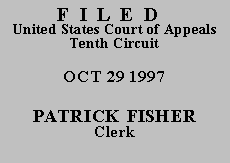

| WILLIAM E. BROWN,
Plaintiff-Appellant, v. JOHN J. CALLAHAN, Acting Commissioner, Social Security Administration, Defendant-Appellee. |
|
Following a lengthy procedural history which we will not repeat here, plaintiff William E. Brown appeals the district court's order affirming the Commissioner's latest determination that he is not entitled to disability benefits. We affirm.
We review the Commissioner's decision to determine whether his factual findings are supported by substantial evidence in light of the entire record and to determine whether he applied the correct legal standards. See Castellano v. Secretary of Health & Human Servs., 26 F.3d 1027, 1028 (10th Cir. 1994). Substantial evidence is "such relevant evidence as a reasonable mind might accept as adequate to support a conclusion." Id. (quotations omitted). In the course of our review, we may "neither reweigh the evidence nor substitute our judgment for that of the agency." Casias v. Secretary of Health & Human Servs., 933 F.2d 799, 800 (10th Cir. 1991).
Mr. Brown alleged disability due to injuries to his back and left wrist, resulting back pain, and diabetes. The administrative law judge (ALJ) determined at step five of the five-step sequential process, see Williams v. Bowen, 844 F.2d 748, 750-52 (10th Cir. 1988), that Mr. Brown was not disabled as he could perform sedentary work.
On appeal, Mr. Brown argues that the ALJ failed to evaluate fully his medical records as to the combined impact of his impairments. Mr. Brown contends he is disabled at step three due to his back injury. See 20 C.F.R. Pt. 404, Subpt. P, App. 1, § 1.05(C). At step three, the ALJ must determine whether a claimant's impairment is equivalent to one of the listed impairments the Commissioner has determined are "so severe as to preclude substantial gainful activity." See Williams, 844 F.2d at 751 (quotation omitted); see also 20 C.F.R. § 404.1520(d). Listing 1.05(C) requires that the claimant have a vertebrogenic disorder which has persisted for at least three months despite prescribed therapy and is expected to last twelve months. The vertebrogenic disorder will be deemed disabling upon repeated findings, see 20 C.F.R. Pt. 404, Subpt. P, App. 1, § 1.00B, of "[p]ain, muscle spasm, and significant limitation of motion in the spine," as well as "[a]ppropriate radicular distribution of significant motor loss with muscle weakness and sensory and reflex loss." Id. § 1.05(C).
The evidence showed that none of Mr. Brown's treating physicians has opined that Mr. Brown is disabled. While the physicians acknowledge he experiences pain, physical findings show neither atrophy of his leg muscles nor marked limitations of his range of motion. Electromyograms have shown no abnormalities. One doctor of osteopathy did opine that Mr. Brown was totally disabled whether or not "orthopedic or neurological evaluation confirms that opinion." Appellant's App. at 268. The ALJ properly rejected this opinion. See Castellano, 26 F.3d at 1029. Mr. Brown failed to show that he met the requirements of § 1.05(C).
Mr. Brown argued to the district court that he could not perform the full range of sedentary work and, because of that, the ALJ erred in determining he was not disabled. On appeal, Mr. Brown appears to have accepted the district court's correct determination that a claimant need only be able to perform other work existing in the national economy, not the full range of work in a specified exertional range in order to be determined not to be disabled. See Williams, 844 F.2d at 751; 20 C.F.R. § 404.1520(f).
Abandoning that issue, Mr. Brown now presents the new argument that the ALJ did not evaluate all the evidence in determining he could perform sedentary work. We will not consider arguments not presented to the district court. See Crow v. Shalala, 40 F.3d 323, 324 (10th Cir. 1994).
The judgment of the United States District Court for the Western District of Oklahoma is AFFIRMED.
Entered for the Court
Circuit Judge
*. This order and judgment is not binding precedent, except under the doctrines of law of the case, res judicata, and collateral estoppel. The court generally disfavors the citation of orders and judgments; nevertheless, an order and judgment may be cited under the terms and conditions of 10th Cir. R. 36.3.